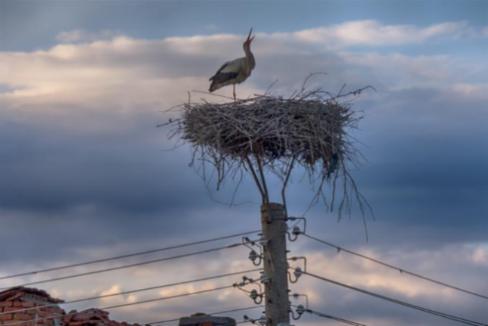The history of storks in Europe is quite dramatic as these beautiful birds were in danger of complete extinction due to the reduced habitats. In the 1950s, the intensive development of agriculture resulted in a decreased wetlands - the main food base for white storks. Only the efforts of environmentalists helped restore the population of the wading birds in bio-reserves and protected areas. As a result, the number of nesting bird pairs in Europe has increased so much that in some countries that people started hunting for these birds again. For example, in France and Italy, storks are hunted for the sake of cooking delicacies, in Malta - for collecting trophies, in other places - just to enjoy the thrill of the hunt.
But fortunately, there is a region in the Balkans where people love and protect these graceful birds. In Serbia, it is traditionally believed that storks bring good luck and prosperity. Special poles with platforms convenient for nesting are made for these birds, and in the spring, the Serbians celebrate the arrival of the first storks. The birds, feeling this care, return to the same places year after year.
So, a stork named “Prvoe” (First) has been migrating to the Serbian village of Tarash (Taraš) for more than ten years). The local people celebrate the Prvoe’s return as a real holiday. They even set up a “Tarash Storks” community in the village and its members take care of every bird that nests in the Banat District. A few years ago, Tarash was given the status of a “European Stork Village”.

Not only Tarash villagers like these birds. Residents of the suburb of Nish (Niš) took great care about the injured stork. A stork baby bird found in the courtyard of a private house could not fly or even stand. The wounds of the bird’s chest and wings were bleeding. Most likely, an inexperienced baby bird fell on a barbed fence. The wounded bird was taken to the Zoo Planet vet clinic in Nish where the baby bird was examined, the wounds were stitched up and antibiotic therapy was prescribed. Now, the state of this bird is monitored not only by the vet clinic staff but also by local media and all caring Serbians.
Another tragic incident in the village of Shashintsy (Šašinci) in the Sremska Mitrovica community attracted everybody’s attention. In July, a female stork died as a result of an electric shock. Five stork baby birds lost their mother. The villagers concerned about the fate of the orphans reported the incident to the local association for the protection of animals. According to an expert ornithologist’s consultation, the birds were not in danger as their father would take care of them. The matter is that storks create strong families to jointly grow and feed their offspring. The baby storks are normally fed in turn by their father and mother. If one of the parents die, the other parent takes care of their baby birds. There are many water bodies around the Shashintsy village, so there will be no problems with food for the little storks. And after 2-3 weeks, they will be able to fly and feed on their own.
Surprisingly, storks settle not only in the villages in Serbia. One of the largest cities in the country, Novi Sad, unexpectedly ranked first in the number of stork pairs nesting here. Nine years ago, the first family of white storks settled on the top of an abandoned building. The incident surprised ornithologists so much that the experts of the Bird Protection and Study Society of Serbia (Društvo za Zaštitu i Proucavanje ptica Srbije, DZPPS) started observing the unusual nesting site. After 3 years, there were already 8 families of white storks here. Last year, the number of nests rose to 31 and this summer, the stork colony in the industrial area of Novi Sad reached a record number. There are 52 family nests last year, and a new generation of birds is growing in each of them!
According to the Bird Protection and Study Society of Serbia, at least 1,500 pairs of white storks come to the country every year to breed. This is a very big number for southern Europe. It seems that storks settle where they are welcome.
Lyubov Ivanova
Photo courtesy of Margarita Kotlyar.


